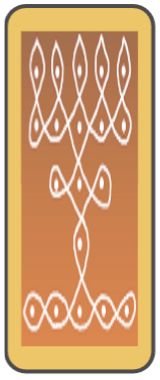 | We learn about........ | |
We have so far learned the general classification of Sanskrit Vowels and Consonants . Another excellent scientific classification is done on Sanskrit alphabet system based on the mouth parts where the sounds originate.
Let us now look at grouping of letters relating to the organ which supports the articulation of the letter. The principal categorization is as follows:
| Gutturals कण्ठ्य | Guttural sounds originate at the throat. |
| Palatals तालव्य | Palatals are pronounced with the help of jaw. |
| Cerebrals मूर्धन्य | Cerebrals are supported by the roof of the mouth. |
| Dentals दन्त्य | Dentals are pronounced by the tongue touching the upper front teeth. |
| Labials ओष्ठ्य | Labials are sounded by the formations of the lips. |
While pronouncing the letters the tongue also play a role along with the above stated mouth parts. The following charts shows the different classification of vowels and consonants and also the role played by the tongue in uttering the letters. You may hear the letters pronounced by clicking the letters.
| Classification - Vowels | |
|---|---|
| Group | Letters |
| Gutturals कण्ठ्य The tongue does not play a role in uttering the sound. | अआ |
| Palatals तालव्य The jaws are spread sidewise a bit. | इई |
| Labials ओष्ठय The lips are rounded to produce the sound. | उऊ |
| Cerebrals मूर्धन्य The tongue closes on the roof of the mouth at length allowing air flow. | ऋॠ |
| Dentals दन्त्य The tongue closes on the upper front teeth allowing air to flow through. | ऌ |
| The tongue does not come in actual contact with the mouth organ that supports the sound origination while articulating a vowel. | |
| Diphthong vowels are formed when two vowels join. Hence they fall in the class combining two groups. | |
| Gutturals + Palatals कण्ठतालव्य | अ + इ = ए आ + इ = ऐ |
| Gutturals + Labials कण्ठोष्टय | अ + उ = ओ आ + उ = औ |
The classification of the first set of consonants Mutes – स्पर्शव्यञ्जनानि are shown below. Consonants in conjunction with vowel अ are given in the table to enable their utterance.
| Classification - Consonants | |||||
|---|---|---|---|---|---|
| Gutturals कण्ठ्य | क | ख | ग | घ | ङ |
| Palatals तालव्य | च | छ | ज | झ | ञ |
| Cerebrals मूर्धन्य | ट | ठ | ड | ढ | ण |
| Dentals दन्त्य | त | थ | द | ध | न |
| Labials ओष्ठ्य | प | फ | ब | भ | म |
We now have a table showing the classification for Semi-Vowels and Sibilants
| Group | Semi-Vowels Antastha (अन्तस्थ) Soft (मृदु) | Sibilants uShma (ऊष्म) Hard (कर्कश) | |
|---|---|---|---|
| Gutturals कण्ठ्य | ह Soft (मृदु) Aspirate (महाप्राण) | ||
| Palatals तालव्य | य | श | |
| Cerebrals मूर्धन्य | रळ | ष | |
| Dentals दन्त्य | ल | स | |
| Labials ओष्ठ्य | व |
Please do not be taken back by sound formations and types. You understand the classification clearly as we advance in our lessons. In the next two lessons we show a comprehensive classification for Swaras (Vowels) and Vyanjanas(Consonants) separately and then move on to learn how to write them.
We welcome your views and suggestions on this lesson. Please post your comments and replies after registering free.
Our next lesson Lesson-4 Sanskrit Vowels स्वराः gives the comprehensive table of classification for all vowels.
 | 0 comments |
To get updates on
संस्कृतवीथी...